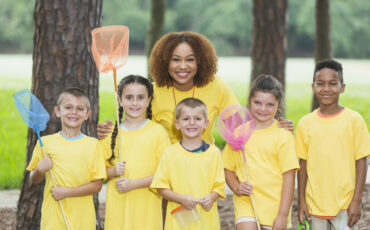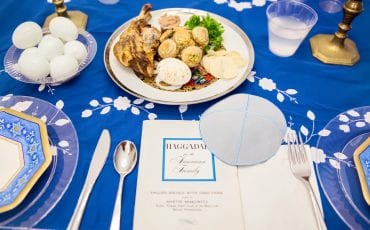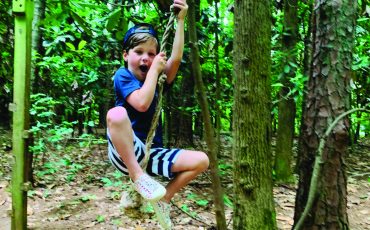An Assist from Apps
Table of Contents
Technology is changing the way kids with special needs learn
by Amanda Allen
Imagine being able to speak for the first time. Or learning to trace the shapes of letters when your motor skills haven’t yet developed. Or hearing a story when your eyesight is limited. These are some of the ways children with special needs are using communications and learning software – the thousands of programs we call apps – every day. The portability of laptops, iPads and Android tablets, iPods and cell phones has given kids access to tools they can use all day long, not just when they’re in front of a home computer.
The beauty of these devices is that most have built-in free software many of us might not be aware of. “I try to get people to use features already included in the device they are using,” says Joan Green, author of the newly published second edition of The Ultimate Guide to Assistive Technology. For instance, two programs on most devices that benefit kids with special needs are text-to-speech, an app that reads aloud the written word, and speech-to-text, which writes spoken words.
Green says it’s important to match the app to the skill your child needs to learn, and of course, “There’s no one magic app for everyone.” One app she likes because it’s inexpensive and works across all devices is Educreations Interactive Whiteboard, which visually represents information. Her book breaks apps into categories – the best ones for autism or visual impairment, for instance.
Through her company in Rockville, Md., Innovative Speech Therapy, she works with families to teach them what’s already available for free and help them identify apps tailored to their specific needs. In Georgia, Lekotek of Georgia (lekotekga.org) and FOCUS (focus-ga.org) can help parents identify apps and support families on their journey. Lekotek also has CompuPlay sessions, a computer club and summer computer camp.
Here’s how some metro Atlanta kids are using technology to learn.

The Hicks Family
Eight-year-old Anthony Hicks Jr. of Lithonia, who has cerebral palsy with visual impairment, has been using iPad programs only eight months, and his mom, Libra Smith-Hicks, is amazed at his progress. Anthony, a first-grader at Rowland Elementary School in Stone Mountain, is nonverbal, and a “yes” and “no” app helps him communicate with his parents. “Before, we had to find creative ways to communicate or guess what he wanted,” Smith-Hicks says. “We were having him look us in the eye if he was answering ‘yes’ to our question, or look away if he wanted to say ‘no.’”
When she and her husband added “Mom” and “Dad” and “good morning” and “good night” to the words Anthony could speak through the iPad, his desire to communicate grew, Smith-Hicks says. “We hope this will allow him to communicate more and also help him with his vision because he has to look closely at it to see what’s on the iPad.” Anthony also loves a storybook app that will read him a story, she says, and he’s developing motor skills by learning to hit the “next” button to hear more.

The Foy Family
Hannah Foy, 6, of Vinings, is an old hand with the iPad – she’s been using it since age 3. Hannah, who has Down syndrome, and her parents Mike and Beth and sister Sarah, 9, play interactive games on the device that help Hannah learn words, colors, shapes, patterns, counting, memory and more. Hanna started out with simple apps such as an Itsy Bitsy Spider program from Duck Duck Moose – the spider sings and moves when you touch it and a snail goes in and out of its shell.
She’s moved on to more complicated learning programs. Some favorite apps are Letter School, which allows Hannah to trace letters with her fingers, and a Fruit Memory game she plays with her big sister. She also likes Peekaboo Barn, which uses fun play with animals to teach words. “What’s so great about the iPad is a very unsophisticated user is able to use it in a meaningful way,” Beth Foy says. “It’s a good tool for parents to work with children, or Hannah can use it on her own. We take it to the Y and use it when Sarah has swim practice.” Hannah, a kindergartener in Cobb County schools, needs help with social communication and soon may be using the device to interact more easily with other children, her mom says.

The Chandler Family
Six-year-old twins Jenna and Mary Chandler of Atlanta are just beginning to explore the iPad world. Mom Tammy Chandler borrowed an iPad over the summer from Lekotek of Georgia, and the girls’ experience was so good she’s hoping to buy a device soon. The twins are continuing to work with learning apps during sessions at Lekotek.
Both girls, born at 27 weeks, have some developmental delays. Jenna has cerebral palsy and uses a walker, and Mary has attention and focus issues. Both are doing well in first grade at Charles R. Drew Charter School.
“They’ve come a long way,” Tammy Chandler says of the girls, who will be 7 soon. Though neither girl has been identified with serious learning disabilities so far, Jenna, who uses a pencil grip to write, is being evaluated for assistive technology to see if a keyboard would help her as writing assignments become more difficult.
The apps the girls loved last summer are Letter School (also a favorite of the Foy family), Dr. Panda’s Restaurant, Toca Boca Hair Salon and Toca Boca Kitchen. Dr. Panda’s app lets kids prepare and serve meals to their animal guests. Toca Boca’s apps help with visual perception and motor skills while offering activities that would particularly appeal to young girls – hair styling and meal preparation.

The Ogden-Reed Family
David Reed, 8, is a bright boy who’s been learning from technology since about age 2, perhaps partially because his father Daniel Reed is in a technical field, as a web developer. “David figured out early on how to work all the devices and how to make them into a TV or device to play his music,” mom Kelly Ogden says. He’s adept at using the iPad to play Pandora music or stream YouTube videos, but he’s also eager to use it for educational purposes, she says.
David has Down syndrome and it usually takes the second-grader at Clairmont Elementary School a little longer to grasp concepts and information, but he gets there eventually, Ogden says. “He’s such a visual learner, and technology gives him immediate access to information.” He and his brother, Adam, 5, in pre-K at College Heights Early Learning Center in Decatur, often play games together that are disguised learning activities. One game they like is Lunchbox Monkey, which teaches colors, letters, counting, shapes, sizes, matching, and differences.
David’s parents have been directing him to educational apps that reinforce information he’s learning at school. For instance, David is learning to read analog clocks at school (digital clocks were a breeze) and the family is using the app Todo Telling Time by Locomotive Labs to reinforce reading a clock to tell the hour, half-hour, quarter-hour and minutes. An app called SkyGuide – you point the iPad toward the night sky and it will tell you the constellations you’re seeing – is building on lessons at school about astronomy. Both boys love that one.
Apps using digital flash cards earlier helped David with words and now are making math more accessible. And with an app called Simply Smarter Memory, David is developing short-term memory. “He has a phenomenal long-term memory,” Ogden says, “but trouble with short-term recall.” And she adds: “It’s a brain exercise, and that’s good for all of us.”








